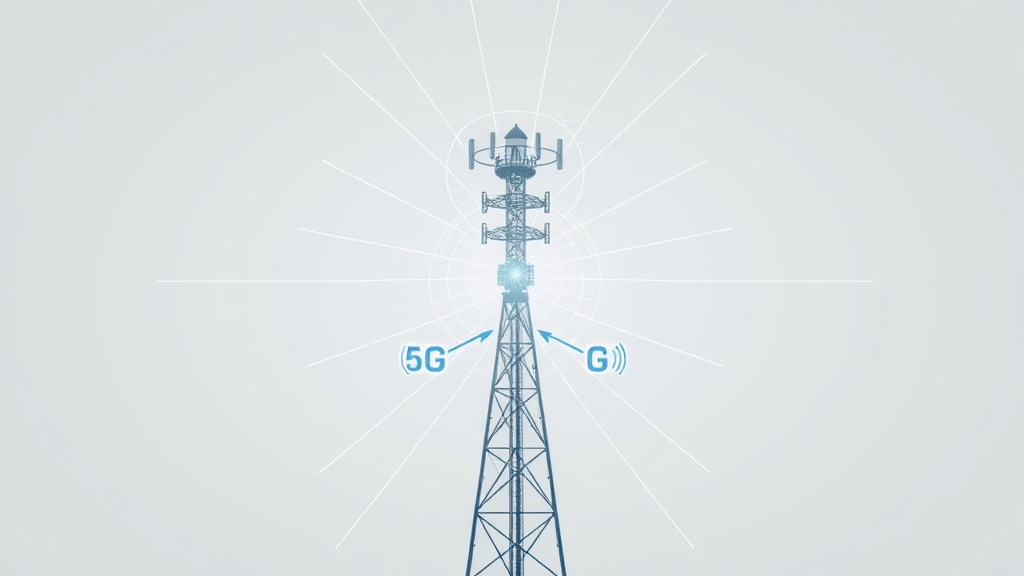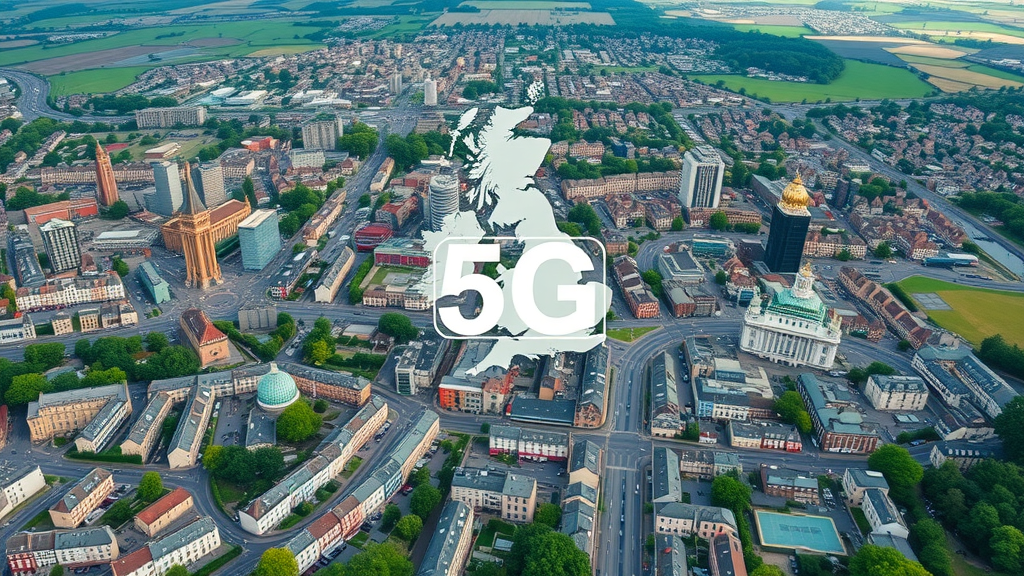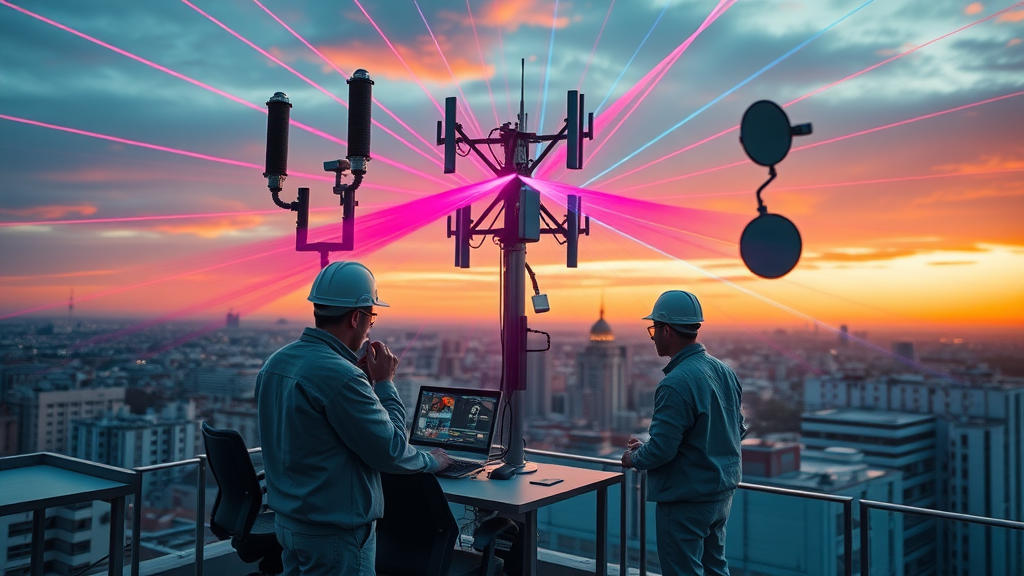Did you know? By 2025, 5G networks are expected to cover one-third of the world’s population, transforming not just how we connect, but how we live, work, and innovate. While most people associate 5G with lightning-fast download speeds, the true story is even bigger—reshaping mobile networks, driving smart homes, and enabling breakthroughs in healthcare and business. Whether you’re a UK homeowner or a business property owner, this friendly, down-to-earth guide will show you how 5G networks are set to change your world in practical, exciting ways.
Discovering the True Influence of 5G Networks
"By 2025, 5G networks are expected to cover one-third of the world’s population, transforming not just how we connect, but how we live, work, and innovate."
The launch of 5G networks isn’t just about significantly faster download speeds or streaming video at higher quality—though those perks certainly grab headlines! In reality, 5G represents a major leap for mobile networks and wireless technology, opening doors to new business use cases, smarter homes, and advanced healthcare solutions. Unlike previous generations that focused on higher data rates and broader coverage, 5G is designed for versatility.
- Understand how 5G networks extend beyond speed improvements.
- Recognise the emerging use cases that benefit businesses and homeowners.
- Learn industry insights on network slicing, new radio, and small cell technology.
- Discover the limitations and opportunities in the UK’s mobile networks landscape.
These changes are happening right across the UK. From London’s glass skyscrapers to small towns enjoying brand-new mobile broadband, the impact of 5G networks is already becoming clear. This article will put you in the driver’s seat, so you can take full advantage of everything this fifth generation cellular network has to offer.

What You'll Learn About 5G Networks
- The key differences between 5G networks and previous generations
- How mobile networks impact business properties and homes
- Unique wireless technology features introduced with 5G
- Practical use cases in the UK today
- Important downsides and limitations of 5G networks
Stick with us as we unwrap how 5G is more than just another mobile network upgrade. You’ll come away knowing how it’ll affect your home, business, and daily life.
A Brief Overview: What Are 5G Networks?
Understanding 5G Networks and Wireless Technology
At its core, 5G networks are the next step up from previous generations of cellular networks—think 2G, 3G, 4G (you probably remember those transformations). What sets 5G apart isn’t just its peak data rates, but how this wireless technology brings low latency (minimal delay), massive network capacity, and the ability to connect a vast number of devices at once. It uses advanced radio wave technologies (like ‘new radio’ and massive MIMO) to ensure quick data delivery.
Whether you’re at home streaming video, in a busy office with lots of connected devices, or out and about using your mobile phone, 5G adjusts resources on the fly to keep everything running smoothly. And for businesses, this means enabling advanced use cases that weren’t practical on older networks, such as smart automation, reliable video streaming in large venues, or connecting hundreds of sensors on a factory floor.
Behind all this, service providers and network operators are rolling out a new kind of network that promises not only significantly faster download speeds but also more reliable connections for everyone—urban or rural, business or home.

The Evolution: From Previous Generations to 5G Networks
Each generation of mobile network technology has brought something new to the table. While 2G gave us the ability for simple texts, and 3G unleashed real web browsing, 4G introduced the era of mobile broadband and video streaming. Now, 5G is taking things a step further, delivering not just higher peak data rates and lower latency, but making wireless technology feel almost invisible in daily life.
Comparing these previous generations to 5G networks reveals improvements not only in speed but also in reliability, connection density (i.e., how many gadgets or sensors can be connected per square kilometre), and even flexibility via things like network slicing. These features are what unlock new business and personal use cases—making smart homes smarter, healthcare more responsive, and factories truly digital.
| Generation | Launched | Peak Data Rate | Core Use Case | Latency | Tech Feature |
|---|---|---|---|---|---|
| 2G | Early 1990s | ~40 kbit/s | Text & Calls | High | Digital Voice |
| 3G | 2000s | ~2 Mbit/s | Web Browsing | Moderate | Packet Switching |
| 4G | 2010s | ~100 Mbit/s | Mobile Broadband/Video | Lower | LTE Network, OFDMA |
| 5G | Late 2010s–Present | >1 Gbit/s | Smart Devices/Automation | Ultra-low | New Radio, Massive MIMO, Network Slicing |
How 5G Networks Are Reshaping Mobile Networks in the UK
Current State: Mobile Network Providers Delivering 5G in the UK
The UK has seen a rapid rollout of 5G networks, with mobile network providers like EE, Vodafone, Three, and O2 racing to bring fifth generation mobile broadband to as many cities and towns as possible. These network operators have invested heavily to build out infrastructure that supports not only faster download speeds, but also the advanced features like network slicing, which allows each business or homeowner to get a tailored network experience.
Today, nearly every major UK city has started to see 5G networks become available, although coverage can still be patchy in some areas. According to leading service providers, more than 100 towns already enjoy some level of 5G, with expectations for expansion into smaller communities over the next couple of years. This broader rollout also means that businesses—from retail shops to manufacturers—can finally take advantage of real-time data, lower latency, and higher connection densities that power everything from automation to safer, smarter premises.
Coverage and Connectivity: How to Tell If 5G Is in Your Area
Unsure if 5G has reached your neighbourhood? It’s easier than ever to check! Every major UK mobile operator and service provider offers detailed coverage maps online. These resources use up-to-date data, showing not only where 5G is live, but what to expect for indoor and outdoor signal strength. Simply enter your postcode to see if high-speed, low-latency connections are already available at your property, or if you’ll need to wait a little longer. Popular tools from EE, Vodafone, and Ofcom’s coverage checker are all designed to make it simple for homeowners and businesses alike to assess their connectivity.
One quick tip: Download speeds and network strength can vary room to room, especially in older buildings with thick walls. So, even if your area is lit up on a map, do a real-world speed test outdoors and indoors to get the best picture of your new 5G experience.
- Tools and resources to check for local coverage
- Network maps from leading providers

The Role of Small Cell Deployments in UK 5G Networks
One essential technology making 5G possible is the widespread use of small cell deployments. While previous generations of cellular network relied on tall towers serving vast areas, 5G uses smaller, more densely scattered antennas, called small cells. This strategy improves data rates and reliability, especially in busy places like city centres, stadiums, offices, and even some residential areas.
By placing these mini base stations closer to users, network operators eliminate many of the coverage and congestion issues that have historically plagued urban areas. These small cell sites also help maintain the low latency 5G is famous for, enabling advanced use cases like real-time industrial monitoring or smart home security.
If you spot new, discreet antennas on lamp posts or rooftops around your area, chances are you’re looking at the future of the mobile network in action!
5G Networks: Real-World Use Cases and Impact
Business Innovations Enabled by 5G Networks
Businesses throughout the UK are taking advantage of 5G networks in ways that simply weren’t possible before. Thanks to features such as higher data rates and network slicing, companies can roll out new digital services, automate routine work, and interact with customers and employees at a whole new level.
From real-time augmented reality (AR) guided repairs on industrial sites to entire office buildings powered by wireless technology instead of ethernet cables, 5G is helping business property owners get ahead. For retailers, easier data collection from smart shelves and sensors offers brilliant insights. Meanwhile, service-based businesses are setting up pop-up shops or mobile broadband offices anywhere, as high-speed, reliable connections become the norm rather than the exception.
Large venues, like sports stadiums, are using 5G networks to stream HD video, allow tens of thousands of smartphones to connect at once, and power advanced crowd monitoring—all in real-time. Property owners, in turn, can offer customizable connectivity and brand-new tenant services.

Homeowner Advantages: Smarter and Safer Homes via 5G Networks
For homeowners, the benefits of 5G go far beyond just faster streaming or online gaming. The real magic is in enabling truly smart living spaces. Imagine front doors equipped with AI-powered security cameras, kitchen appliances that order groceries as you run low, or heating and lighting systems that learn your preferences—all communicating securely and instantly through 5G networks.
This level of connectivity means smarter homes can automatically detect and respond to emergencies, optimize their energy use, and even help care for elderly family members via advanced remote health monitoring. Not only does this make life more convenient, it can raise your property’s value, offering something unique to today’s tech-savvy buyers and renters.
Healthcare Advances Driven by 5G Networks
The healthcare sector is seeing some of the most groundbreaking use cases for 5G networks. Imagine remote consultations with doctors who can review high-definition video and patient vital signs in real-time, without costly delays or signal drops. Specialists can even guide surgeons remotely during operations, thanks to the low latency and high reliability of 5G’s wireless technology.
Hospitals and clinics now use wireless sensors and tablets to monitor patients continuously, analyzing incoming data and issuing instant alerts if something changes. This helps provide better care and reduces the average length of hospital stays—directly benefiting both providers and patients. Ultimately, these innovations mean faster diagnoses, more precise treatments, and a healthcare system that can reach even remote areas reliably.

Transportation and Logistics: 5G Networks on the Move
The logistics industry, and anyone who sells, delivers, or receives goods, will see huge improvements from 5G networks. Thanks to faster data rates and low latency, everything from autonomous lorries and driverless taxis to delivery drones and warehouse robots can communicate and react in real-time.
For business property owners, expect better traffic management, fleet tracking, and reduced delays due to instantly updated traffic, weather, and route data. For households, 5G-powered delivery vehicles mean faster, more efficient online shopping—even to rural areas previously left out by slow, unreliable mobile networks.

Entertainment & Augmented Reality as a 5G Network Use Case
Video streaming, mobile gaming, and augmented/virtual reality (AR/VR) have all leapt forward thanks to 5G networks. Now, families and businesses alike can enjoy buffer-free video streaming, multi-user virtual events, and interactive training—all over the air.
For property owners, this means homes and offices can become entertainment hubs, and businesses can provide next-generation experiences to their customers. Imagine a real estate agent offering virtual 360-degree property tours, or a local museum hosting AR exhibits for school kids, all powered by ultra-high bandwidth and reliable connections that only 5G can deliver.
Understanding the Key Technologies Behind 5G Networks
What Is 'New Radio' in 5G Network Architecture?
The ‘New Radio’ (NR) standard is what powers 5G’s ability to deliver massive improvements over previous generations. Unlike the LTE network used for 4G, new radio is based on flexible spectrum usage—it works across low, mid, and high-frequency bands. This means better coverage in rural areas and super-fast speeds in dense cities.
By allowing a more efficient air interface (the way devices talk to the base station), NR enables 5G networks to serve more users, at higher data rates, and with less congestion.
How Network Slicing Makes 5G Networks Unique
Network slicing is one of the most innovative features of 5G networks. Think of it as creating several ‘mini-networks’ on top of a single physical one. Each slice can be tailored—one for emergency services, another for high-speed business data, a third for smart home gadgets—with their own security and performance criteria.
For property owners and businesses, this means you could have a slice prioritised for security alarms, while another handles lighting or entertainment. For service providers and mobile operators, it unlocks new business models and value-added offerings.
Network slicing is a game-changer, making it possible to meet the needs of different users efficiently, with no extra hardware.
Massive MIMO and Beamforming: Enhancing Wireless Technology
Massive MIMO (Multiple Input, Multiple Output) and beamforming are advanced antenna technologies that underpin 5G’s higher performance. Massive MIMO means dozens or even hundreds of small antennas work together to increase network capacity and serve more devices.
Beamforming uses software to direct signals straight to where users are, instead of in all directions, which leads to better data rates and reduces interference. The result? Reliable wireless technology, even in crowded environments or inside thick-walled buildings.

Energy Efficiency: Are 5G Networks Greener?
Sustainability is becoming more important for homeowners and business owners alike. While building 5G networks takes energy and resources, the technology is much more efficient than previous generations. Each unit of data uses less energy per second—and features like network slicing and small cell deployments help keep power consumption smart and targeted.
The result? Over time, 5G networks should offer higher performance at a lower cost to the environment, especially compared to previous wireless technologies.
| Technology | 2G | 3G | 4G | 5G |
|---|---|---|---|---|
| Radio Access | GSM | UMTS | LTE (FDD/TDD) | New Radio (NR) |
| Antenna System | Traditional | MIMO (Basic) | MIMO | Massive MIMO & Beamforming |
| Network Design | Macro Cells | Macro Cells | Macro + Small Cells | Small Cell-centric |
| Unique Feature | Voice Calls/SMS | Mobile Data | High-speed Broadband | Network Slicing, Ultra-low Latency |
Challenges and Limitations Facing 5G Networks
What Are the Downsides to 5G?
- Coverage gaps in rural areas and some urban pockets
- Device compatibility issues with 5G networks
- Potential concerns for wireless technology and health
While 5G networks offer exciting new use cases and impressive data rates, not everything is perfect. Many rural and some inner-city areas still face coverage gaps, partly due to the need for many small cells and the challenges of building dense networks everywhere. Device compatibility is another factor—older smartphones simply can’t take advantage of new radio waves, so upgrading may be necessary. Last, while research shows 5G is safe, health concerns linger among some groups, despite there being little concrete evidence.
"While 5G networks promise faster speed and greater connectivity, challenges around infrastructure and universal coverage must be addressed."

Debunking Common Myths About 5G Networks
Addressing Health & Safety Concerns of Wireless Technology
Health and safety concerns about wireless technology have been around since the first radio waves beamed across the country—5G is no different. However, the consensus from scientists and health organizations (including Public Health England and the World Health Organization) is that 5G does not pose a new health risk when installed and used correctly.
5G networks operate within established safety guidelines, and their signals are typically even lower power than those from previous generations. Smart design, such as using small cells instead of just bigger towers, further minimises any exposure. For homeowners, this means you can relax and enjoy your fast, reliable wireless connection with peace of mind.

Examining Cost Myths: Are 5G Networks Expensive for Property Owners?
Some homeowners and business owners worry that updating to 5G will be costly. The good news is, while you might need a 5G-ready device, you won’t necessarily pay more for your service. In fact, as more service providers introduce 5G, competition is driving prices down. You can even expect lower cost per data unit, thanks to the efficiency of mobile network technology. For businesses, investment in smart 5G wireless solutions can actually reduce overall costs by making processes faster, safer, and easier to manage.
How 5G Networks Shape the Future of the Internet of Things (IoT)
- Opportunities for smart cities
- Industrial automation powered by 5G networks
- Everyday smart devices enhanced by advanced wireless technology
5G networks are the backbone of the growing Internet of Things (IoT), connecting everything from lampposts and vehicles to medical devices and kitchen appliances. Town councils and businesses are already piloting projects for smart city energy grids, intelligent parking, and safer, responsive public transport. In the home, 5G means easier setup and ultra-reliable performance for everything already connected to Wi-Fi, plus hundreds of new gadgets to come.
Industrial automation is also taking off, with 5G networks enabling instant communication between robots, AI-powered quality inspection, and fast remote problem-solving. Everyday life will see more responsive smart speakers, smarter heating, and secure monitoring—all backed up by faster, more robust wireless technology.
People Also Ask: Answers to Top 5G Networks Queries
What is the 5G Network?
The 5G network is the fifth generation of mobile networks, offering much faster data rates, lower latency (lag), and the ability to connect more devices at once compared to previous generations. It's the new standard for both mobile and wireless technology, providing a platform for advanced smart devices and services from video streaming to industrial automation.
Which Network Provides 5G in the UK?
In the UK, all four major mobile network providers—EE, Vodafone, O2, and Three—offer 5G services, with coverage expanding year on year. Regional providers and mobile virtual network operators also use these networks for their own 5G-enabled plans.
What is the Downside to 5G?
The main downsides to 5G networks are incomplete coverage, especially in rural areas, and the need for a compatible device. Some users voice health concerns, but current evidence shows 5G is safe when used within regulated guidelines. Also, infrastructure upgrades can take time and investment.
How Do I Know if 5G Is in My Area?
You can check 5G coverage in your area using the online maps provided by all major UK mobile operators or regulatory bodies like Ofcom. Enter your postcode for detailed, localised information, and always test network performance at your property to confirm what you can expect indoors and outdoors.
FAQs: 5G Networks for Businesses and Homeowners
-
Can my existing devices connect to 5G networks?
Only phones, tablets, and devices that specifically support 5G can connect to these networks. You may need to upgrade from 4G/LTE devices to benefit from the full range of 5G features. -
How will 5G affect property values?
Properties with access to strong, reliable 5G networks may see their value or rental appeal increase, especially in tech-driven markets or among younger, connected buyers. -
Will 5G technology replace Wi-Fi in homes?
For now, Wi-Fi and 5G will work together, not instead of each other. 5G may power wireless broadband in some homes, but Wi-Fi will still dominate inside due to device compatibility and existing infrastructure. -
Are there data security concerns with 5G networks?
Like any internet technology, 5G security depends on proper setup and best practices. While 5G introduces more robust security by default, always keep devices and apps updated, and use strong passwords.
Key Takeaways
- 5G networks deliver more than speed – they enable new business and personal opportunities.
- UK mobile networks are rapidly rolling out 5G with expanding coverage.
- Small cell and network slicing technologies are pivotal to the future of wireless technology.
- Challenges remain for 5G networks, but the benefits for homeowners and businesses are growing fast.
Conclusion: Harnessing the Power of 5G Networks in Everyday Life
Embrace the 5G revolution—and enjoy a smarter, safer, more connected future at home and at work.
Share Your Thoughts on 5G Networks!
Got questions or want to share your 5G experience? We'd love to see your comments on this!
To deepen your understanding of 5G networks and their transformative impact, consider exploring the following resources:
-
“What Is 5G? How 5G Network Technology Works” by Cisco provides a comprehensive overview of 5G technology, detailing its capabilities, benefits, and the underlying architecture that sets it apart from previous generations. (cisco.com)
-
“What is 5G?” by Nokia delves into the specifics of 5G’s speed, latency, and capacity improvements, offering insights into how this technology is revolutionizing wireless communications and enabling new services and applications. (nokia.com)
These articles offer valuable perspectives on the advancements and practical applications of 5G networks, enhancing your grasp of their real-world impact.
 Add Row
Add Row  Add
Add 





Write A Comment